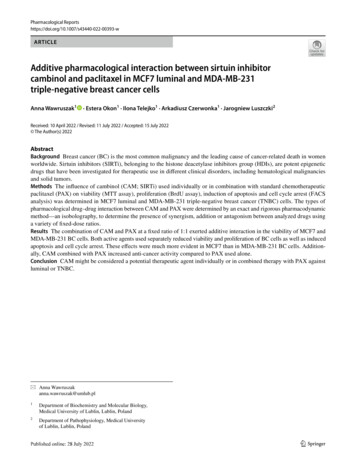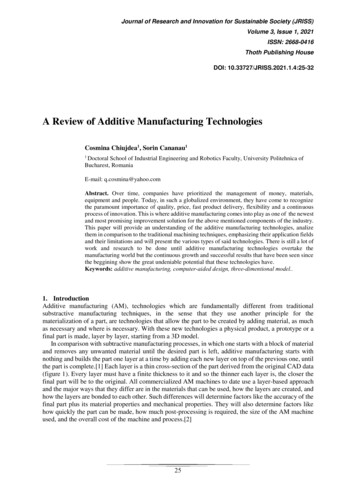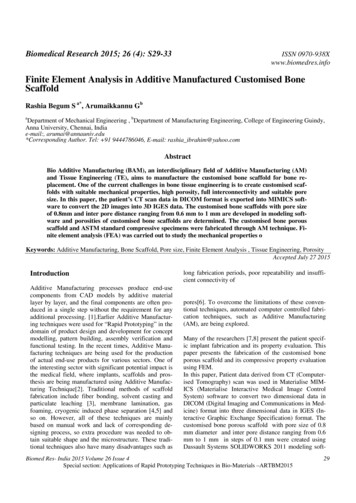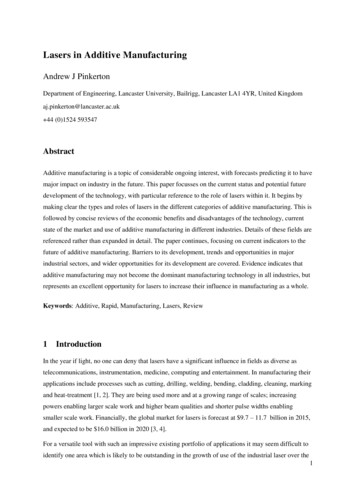
Transcription
Pharmacological RTICLEAdditive pharmacological interaction between sirtuin inhibitorcambinol and paclitaxel in MCF7 luminal and MDA‑MB‑231triple‑negative breast cancer cellsAnna Wawruszak1· Estera Okon1 · Ilona Telejko1 · Arkadiusz Czerwonka1 · Jarogniew Luszczki2Received: 10 April 2022 / Revised: 11 July 2022 / Accepted: 15 July 2022 The Author(s) 2022AbstractBackground Breast cancer (BC) is the most common malignancy and the leading cause of cancer-related death in womenworldwide. Sirtuin inhibitors (SIRTi), belonging to the histone deacetylase inhibitors group (HDIs), are potent epigeneticdrugs that have been investigated for therapeutic use in different clinical disorders, including hematological malignanciesand solid tumors.Methods The influence of cambinol (CAM; SIRTi) used individually or in combination with standard chemotherapeuticpaclitaxel (PAX) on viability (MTT assay), proliferation (BrdU assay), induction of apoptosis and cell cycle arrest (FACSanalysis) was determined in MCF7 luminal and MDA-MB-231 triple-negative breast cancer (TNBC) cells. The types ofpharmacological drug–drug interaction between CAM and PAX were determined by an exact and rigorous pharmacodynamicmethod—an isobolography, to determine the presence of synergism, addition or antagonism between analyzed drugs usinga variety of fixed-dose ratios.Results The combination of CAM and PAX at a fixed ratio of 1:1 exerted additive interaction in the viability of MCF7 andMDA-MB-231 BC cells. Both active agents used separately reduced viability and proliferation of BC cells as well as inducedapoptosis and cell cycle arrest. These effects were much more evident in MCF7 than in MDA-MB-231 BC cells. Additionally, CAM combined with PAX increased anti-cancer activity compared to PAX used alone.Conclusion CAM might be considered a potential therapeutic agent individually or in combined therapy with PAX againstluminal or TNBC.* Anna Wawruszakanna.wawruszak@umlub.pl1Department of Biochemistry and Molecular Biology,Medical University of Lublin, Lublin, Poland2Department of Pathophysiology, Medical Universityof Lublin, Lublin, Poland13Vol.:(0123456789)
A. Wawruszak et al.Graphical abstractKeywords Breast cancer · Histone deacetylase inhibitor · Sirtuin inhibitor · Cambinol · Paclitaxel · Anticancer drugsAbbreviationsANOVA Analysis of varianceATTC American Type Culture CollectionBC Breast cancerBrdU 5-Bromo-2'-deoxyuridineCAM CambinolCDDP CisplatinCRR Concentration–response relationshipDMEM Dulbecco's modified Eagle's mediumDMSO Dimethyl sulfoxideDOX DoxorubicinER Estrogen receptor positiveF ratio Factor for slope function ratioFACS Fluorescence-activated cell sortingFBS Fetal bovine serumFDA Food and Drug AdministrationHATs Histone acetyltransferasesHCC Hepatocellular carcinomaHCl Hydrochloric acidHDACs Histone deacetylasesHDIs Histone deacetylase inhibitors13IC50 add IC50 theoretically calculated as an additiveIC50 mix IC50 for the mixtureKi-67 Proliferation index-67MTT um bromiden Number of itemsnadd Number of items calculated for the additivemixtureNC Not collateralnmix Number of items for the experimental mixtureNAD Nicotinamide adenine dinucleotidePAX PaclitaxelPBS Phosphate-buffered salinePI Propidium iodideRT Room temperatureS Slope function ratioSD Standard deviationSDS Sodium dodecyl sulfateSEM Standard error of the meanSIRTi Sirtuin inhibitor
Additive pharmacological interaction between sirtuin inhibitor cambinol and paclitaxel TMB TetramethylobenzidineTNBC Triple-negative breast cancerIntroductionBreast cancer (BC) was a leading cause of morbidity andmortality in women worldwide in 2021 [1]. Nowadays, BCis still the foremost cause of cancer-related deaths in women.Moreover, the incidence and mortality rates are expected toincrease significantly in the following years. Despite significant progress in BC research and therapy, BC remainsa serious clinical problem and represents a top oncologicalresearch priority. The standard therapeutic options dependon the subtype of BC and contain surgery, radiotherapy,chemotherapy, hormone therapy and immunotherapy [2].The estrogen receptor-positive (ER ) subtype of BCaccounts for approximately 75% of all BC cases. Endocrinetherapy using aromatase inhibitors, selective ER modulators and ER-down-regulators provide appreciable clinicalbenefits through the reduction of BC recurrence and mortality. Anyhow, resistance to endocrine therapies is a severeobstacle limiting the effectiveness of ER BC treatment [3].In turn, the most aggressive subtype of BC—triple-negativebreast cancer (TNBC) accounts for 10–20% of all cases.Due to the lack of hormone receptors expression, hormonetherapy is mainly ineffective for TNBC. Nonetheless, TNBCresponds very well to traditional chemotherapy, which constitutes the most often recommended type of treatment [4].Paclitaxel (PAX) is a tetracyclic diterpenoid that was firstisolated from the bark of the Pacific yew tree. PAX, as highefficient and broad-spectrum natural anti-cancer drug, hasbeen widely used in the therapy of ovarian, uterine, testisand other cancers [5]. PAX is also a frontline chemotherapydrug in BC treatment, especially in advanced metastaticcancer and TNBC. Unfortunately, resistance to PAX oftenimpedes clinical management and adversely affects patientoutcomes. To minimize or eliminate PAX resistance, diterpenoid is combined with other natural or synthetic chemotherapeutic agents [6].New beneficial, targeted therapies combined withPAX are investigated to achieve better clinical outcomesin patients with BC [4]. Epigenetic abnormalities haveemerged as an important hallmark of cancer developmentand progression. Given that histone deacetylases (HDACs)are essential to chromatin remodeling, their inhibitors havebecome promising anti-cancer drugs [7]. Histone deacetylase inhibitors (HDIs) are a relatively new class of antineoplastic agents that plays a vital role in the epigenetic andnon-epigenetic regulation in cancer, including cell death,apoptosis or cell cycle arrest in cancer cells [7]. A balance inthe activity of opposing enzymes: histone acetyltransferases(HATs) and histone deacetylases (HDACs), is indispensablein the epigenetic regulation of gene expression. Impairmentin the balance between HATs and HDACs has been reportedin the development of BC. Through the targeting of histoneas well as non-histone proteins, HDIs maintain the cellularacetylation profile and reverse the function of several proteins responsible for BC development [8].Sirtuins (SIRTs) belong to the 3rd class of HDACs. SIRTsrequire NAD as a cofactor and include SIRT1-7 proteinsin mammals [9]. Cambinol (CAM) is a cell-permeableβ-naphthol derivative that inhibits the activity of SIRT1 andSIRT2 [10]. It has been demonstrated that CAM enhancesthe cell response to PAX treatment in Burkitt lymphomaxenografts [10, 11]. All these findings suggest that SIRTshave a pivotal role in facilitating adverse effects of standardchemotherapeutics through reduction of their doses in combinatorial therapy [10].According to our knowledge, there are no studies regarding the effect of CAM and PAX treatment in BC. Therefore, our present study aimed to investigate the anti-canceractivity of CAM individually or in combination with PAXto establish if this kind of treatment could enhance its antiproliferative and pro-apoptotic activity in MCF7 luminaland MDA-MB-231 TNBC cells. Types of pharmacologicalinteractions between CAM and PAX were determined usingthe advanced pharmacokinetic isobolographic method.Materials and methodsCell lines and culture conditionsThe human MCF7 luminal and MDA-MB-231 TNBC cells(American Type Culture Collection; ATTC; Manassas,VA, USA) were incubated in Dulbecco's modified Eagle'smedium (DMEM)/HAM’s F12 (Sigma, CA, USA) supplemented with 10% fetal bovine serum (FBS), penicillin(100 IU/mL) and streptomycin (100 µg/mL) (Sigma). Cultures were kept at 37 C in a humidified atmosphere of 95%air and 5% CO2.Drug treatmentPAX (Sigma) and CAM (Sigma) were dissolved in dimethylsulfoxide (DMSO) (Sigma) at 1 mM and 10 mM, respectively. To obtain the final drugs’ concentrations, stocksolutions were diluted in the DMEM/HAM’s F12 culturemedium.Cell viability assessmentCell viability was measured using the MTT (4,5-dimethylthiazol-2-yl)-2,5-diphenyltetrazolium bromide) method, basedon the ability of the mitochondria of viable cells to reduce13
A. Wawruszak et al.yellow tetrazolium salt (MTT) to purple formazan crystals.MCF7 and MDA-MB-231 BC cells (1 104 cells/ml) wereincubated with PAX (0.001–1 µM) and CAM (0.01–0.1 mM)individually or in combination for 96 h. Following, BC cellswere incubated with MTT solution at 5 mg/ml for 3 h. Theabsorbance was measured at 570 nm with an Infinite M200Pro microplate reader (Tecan, Männedorf, Switzerland) afteradding sodium dodecyl sulfate (SDS) buffer (10% SDS in0.01 N HCl) overnight.Isobolographic analysis of PAX/CAMpharmacological interactionsClassification of pharmacodynamic interactions of PAXwith CAM was performed by means of the type I isobolographic analysis for non-parallel concentration–effect curvesin two BC cell lines, as described in detail earlier [12, 13].In this study, the log-probit method allowed the determination of concentration–effect curves for PAX and CAM, whenadministered either alone or in combination at the fixedratio of 1:1. The % of the inhibition of BC cell viability wastransformed to probit (in two MCF7 and MDA-MB-231 celllines measured by the MTT assay). After determining themedian inhibitory concentrations ( IC50s) for PAX and CAM,the test of parallelism between concentration–effect curvesof PAX and CAM was performed as described in detail earlier [13]. Since the concentration–effect curves for PAX andCAM were non-parallel to each other, we calculated two IC50 theoretically calculated as additive ( IC50 add) values forlower and upper isoboles of additivity, as presented earlier[14–16]. Additivity was present if the I C50 mix values areplaced close to or within the area bounded by the lower andupper isoboles of additivity [17].Finally, 1 M sulfuric acid was added (25 µL/well) to stop theenzymatic reaction, and quantitation was performed spectrophotometrically at 450 nm using an Infinite M200 Pro microplate reader (Tecan).Detection of apoptosisThe assay was performed using PE Active Caspase-3 Apoptosis Kit (BD Pharmingen, San Diego, CA, USA). The BCcells were seeded at 1 105/ml on 6-well plates (Nunc) andtreated with PAX and CAM alone or in combination (PAX/CAM) for 48 h. Then, cells were washed with phosphate-buffered saline (PBS), fixed and permeabilized using the Cytofix/Cytoperm Solution according to the manufacturer’s protocol.Finally, cells were washed twice in the Perm/Wash Bufferbefore intracellular staining with PE-conjugated anti-activecaspase-3 monoclonal rabbit antibodies. Labeled cells wereanalyzed by FACSCalibur (BD Biosciences), operating withCellQuest software.The cell cycle assessmentThe cell cycle assessment was performed with the FACS Calibur Flow Cytometer (BD Biosciences) equipped with anargon-ion laser (488 nm). In the beginning, BC cells werefixed with 70% ethanol at 20 C. After that step, the cellswere stained with propidium iodide (PI) utilizing PI/RNaseStaining Buffer (BD Biosciences), according to the manufacturer's protocol. The course of the cell cycle was determinedby a non-commercial flow cytometry analyzing software—WinMDI 2.9 (facs.scripps.edu/software.html) and CylchredVersion 1.0.2 (University of Wales, UK). 10,000 events wererecorded and an acquisition rate was 60 events/second.Statistical analysisCell proliferation assay (ELISA BrdU)Cell proliferation was evaluated with Cell Proliferation Elisa,BrdU Kit (Roche, Germany). Optimized amounts of MCF7and MDA-MB-231 BC cells (1 104 cells/ml) were placed ona 96-well plate (Nunc, Rochester, NY, US) and treated withPAX and CAM (1/2 IC50 and IC50) individually or in combination for 48 h, followed by 10 µL/well BrdU Labeling Solution(100 µM) which was added, and cells were reincubated foran additional 24 h at 37 C. Then, the culture medium wasremoved and cells were fixed in FixDenat solution (200 µL/well) (30 min, room temperature (RT)). The solution of antiBrdU antibody coupled with horseradish peroxidase was subsequently added (100 µL/well) for 90 min at RT, and detectedusing tetramethylbenzidine substrate (TMB) (100 µL/well).13Statistical analysis was performed using GraphPad Prism 5software. One-way analysis of variance (ANOVA test) withTukey’s post hoc testing was used for multiple comparisons. The normal distribution to justify parametric statistical methods was checked using the Shapiro–Wilk normalitytest. Results were statistically relevant if p 0.05 (*p 0.05,**p 0.01, ***p 0.001). All the I C50 values for PAX andCAM (when administered singly and in combination) werecomputed by means of the log-probit analysis. The Student’st test with Welch correction was used to statistically comparethe experimentally derived I C50 mix values with their respective theoretical additive I C50 add values, as presented elsewhere[13].
Additive pharmacological interaction between sirtuin inhibitor cambinol and paclitaxel ResultsDecrease of MCF7 luminal and MDA‑MB‑231 TNBCviability after CAM and PAX treatment administeredindividually or in combinationIn this experiment we determined the cell growth inhibitory activity of CAM and PAX [18] using um bromide (MTT)assay. The influence of both active agents on the viabilityof MCF7 luminal and MDA-MB-231 TNBC cell lineswas done to determine the I C50 values, which were calculated based on the log-probit analysis of the concentration–response relationship (CRR) effects and they wereshown in Table 1. Analyzed BC cell lines were exposedto a clear culture medium (control) or increasing concentrations of CAM (0.01–0.1 mM) (Fig. 1) and PAX(0.001–1 µM) [18]. As shown in Fig. 1, CAM administeredindividually reduced cell viability in both investigated BCTable 1 Half-maximalinhibitory concentrations (IC50 SEM) for cambinol(CAM) and paclitaxel(PAX) [18] in MCF7 andMDA-MB-231 breast cancer(BC) cellscell lines in a dose-dependent manner compared with control (untreated cells). The cytotoxic effect of CAM wasweaker in MCF7 luminal BC cells (IC50 57.87 3.48 µM;Fig. 2) (one-way ANOVA, number of groups 11, F 313.4,R square 0.9477, df 183 (total)) than in MDA-MB-231TNBC cells ( IC 50 40.28 4.10 µM; Fig. 2) (one-wayANOVA, number of groups 11, F 1774, R 2 0.9896,df 197 (total)). Then, we analyzed the dose-relatedinhibitory effects of CAM and PAX on BC cells to subsequently find out whether a combination of CAM withPAX can enhance the anti-cancer activity of this agent. Todetermine the cytotoxic effect of PAX and CAM in combination, BC cells were incubated with a 1:1 drug mixture in increasing, different ratios of IC50 (2.0 IC50 ofPAX IC50 of CAM). Similar to individual treatment, wehave shown the concentration-dependent inhibition of BCcell viability in both analyzed BC cell lines (Fig. 3). Asopposed to a single therapy, the MCF7 cell line was moresensitive to PAX/CAM combined treatment than MDAMB-231 TNBC cells.Cell lineDrugIC50 (μM)NSf ratioCollateralismMCF7PAXCAMPAXCAM0.0157 0.0065 [18]57.87 3.480.0017 0.0005 [18]40.28 e parallelism between the dose–response lines of PAX and CAM was assessed by means of the logprobit method as described earlier [13, 18]n number of items, S slope function ratio, f ratio factor for slope function ratio, NC not collateralA.B.MCF7100***6040***20*** *********010080604020****************** ****** *** ***ctr0.010.020.030.040.050.060.070.080.090.100CAM [mM]Fig. 1 The effect of cambinol (CAM) (0.01–0.1 mM) on the viability of A MCF7 and B MDA-MB-231 human breast cancer (BC) celllines was measured by (4,5-dimethylthiazol-2-yl)-2,5-diphenyltetrazolium bromide (MTT) assay after 96 h. Data are presented -MB-231120Ce ll v iab ility [% o f ctr ]Ce ll v iab ility [% o f ctr ]120CAM [mM]mean standard deviation ( SD) of the mean, n 18 per concentration from three independent experiments. One-way ANOVA, Tukey’spost hoc testing. *p 0.05, **p 0.01, ***p 0.00113
A. Wawruszak et al.Fig. 2 Concentration–effect relationship curves (CECs) for paclitaxel(PAX) and cambinol (CAM) when administered singly and combinedin a fixed ratio of 1:1 for A MCF7 and B MDA-MB-231 cells. Concentrations of CAM and PAX were transformed into logarithms andthe anti-proliferative effects into probits. Linearly related equations ofB.MCF71201006040*** ************ ********* *** ***2001008060MDA-MB-231** ********* ******40****** 0Ce ll v ib ility [% o f co n tr o l]120ctr0.40.60.81.01.21.41.61.82.02.2Ce l l v i a b i l i t y [ % o f c o n t r o l ]A.CECs are presented on the graph. The dotted line reflecting the 5 thprobit indicates the IC50 values for PAX and CAM. Test of parallelism between PAX and CAM indicated that both lines are not parallelto each otherPAX:CAMFig. 3 The effect of paclitaxel (PAX) and cambinol (CAM) (1:1) onthe viability of A MCF7 and B MDA-MB-231 human breast cancer (BC) cell lines was measured by the (4,5-dimethylthiazol-2-yl)2,5-diphenyltetrazolium bromide (MTT) test after 96 h incubation.Different ratios of the PAX and CAM I C50 (2.0 IC50 IC50) wereused. Data are presented as mean standard deviation ( SD) of themean, n 18 per concentration from three independent experiments.One-way ANOVA, Tukey’s post hoc testing. **p 0.01, ***p 0.001Log‑probit concentration–response effects of CAM,PAX, and their combination (CAM PAX) in the MCF7and MDA‑MB‑231 cell lines1:1 produced also the anti-proliferative effect with logprobit equation (y 1.2688x 3.0887; R2 0.9492) and IC50 mix value amounting to 32.088 µM in the MCF7 cellline (Fig. 2A; Table 2). Similarly, in the MDA-MB-231cell line, the linearly related log-probit equation for CAM(y 2.9203x 0.3126; R2 0.9656) allowed calculatingthe IC50 value, which was 40.282 µM (Fig. 2B; Table 1).For PAX, the log-probit equation (y 0.8498x 6.4705;R2 0.9805) allowed calculating the I C50 value, whichamounted to 0.0017 µM in the MDA-MB-231 cell line(Fig. 2B, Table 1). Additionally, the combination of bothdrugs (CAM PAX) at the fixed ratio of 1:1 exertedthe anti-proliferative effect with log-probit equation(y 2.4801x 1.2936; R 2 0.9656) and I C 50 mix valueamounting to 31.22 µM in the MDA-MB-231 cell lineBoth, CAM and PAX exerted, in a concentration-dependentmanner, the anti-proliferative effect in the MTT assay inboth, MCF7 (Fig. 3A), and MDA-MB-231 (Fig. 2B) celllines, respectively. For CAM, the linearly related log-probitequation (y 4.943x 3.7124; R2 0.8953) allowed calculating the IC50 value, which was 57.868 µM in the MCF7cell line (Fig. 2A; Table 1). For PAX, the log-probit equation (y 0.9302x 6.6789; R2 0.9963) allowed calculating the IC50 value, which amounted to 0.0157 µM in theMCF7 cell line (Fig. 2A; Table 1). Additionally, the combination of both drugs (CAM PAX) at the fixed ratio of13
Additive pharmacological interaction between sirtuin inhibitor cambinol and paclitaxel Table 2 Isobolographic analysis of pharmacological drug–drug interactions between paclitaxel (PAX) and cambinol (CAM) in MCF7 andMDA-MB-231 breast cancer (BC) cellsCell lineIC50 mix (μM)nmixLower IC50 add (μM)naddUpper IC50 add (μM)InteractionMCF7MDA-MB-23132.09 7.5131.22 4.181209610.23 5.5913.19 3.8118818847.69 6.8627.10 4.02AdditivityAdditivityResults are I C50 values ( SEM) for the mixture of PAX and CAM determined experimentally ( IC50 mix) and theoretically calculated as an additive (IC50 add), which inhibit proliferation in MCF7 and MDA-MB-231 BC lines, as measured in the MTT assay. The experimentally derived IC50 mix values for the mixture of PAX with CAM were statistically compared with their respective theoretical additive I C50 add values by the useof unpaired Student’s t test with Welch correction, according to Tallarida [16]nmix number of items for the experimental mixture, nadd number of items calculated for the additive mixture(Fig. 2B; Table 2). The test of parallelism between log-probitconcentration–response lines for CAM and PAX revealedthat both log-probit lines are not parallel to each other in thetwo tested cell lines (MCF7; Fig. 2A and MDA-MB-231;Fig. 2B).Type I isobolographic analysis of drug–drugpharmacological interaction between CAM and PAXin MCF7 and MDA‑MB‑231 BC cellsThe isobolographic analysis of interaction revealed thatthe mixture of PAX with CAM at the fixed ratio of 1:1exerted additive interaction in the MCF7 breast cancercells (Fig. 4A). The experimentally determined I C50 mixvalue was 32.088 µM and was placed on isobologramwithin the area bounded by the lower and upper isobolesof additivity (Fig. 4A). The theoretically calculatedFig. 4 Isobolographic analysis of interactions between paclitaxel(PAX) and cambinol (CAM) in (A) MCF7 and (B) MDA-MB-231breast cancer (BC) cells. Isobolograms display additive interactionsbetween PAX and CAM with respect to their anti-proliferative effectsin MCF7 and MDA-MB-231 cell lines measured in vitro by ium bromide (MTT)assay. The I C50 values for CAM and PAX are plotted graphically on IC50 add values, accepted as additive, were 10.228 µM forthe lower and 47.691 µM for the upper isoboles, respectively (Fig. 4A). The experimental IC50 mix value for thiscombination did not significantly differ from the computed I C 50 add values with Student’s t test with Welch correction (t 1.534, df 277.6, p 0.1262, Table 2, Fig. 4A).Similarly, in the MDA-MB-231 cancer cell line, the mixture of PAX with CAM at the fixed ratio of 1:1 exertedadditive interaction (Fig. 4B). The experimentally determined IC50 mix value was 31.22 µM and was placed on anisobologram slightly above the area bounded by the lowerand upper isoboles of additivity (Fig. 4B). The theoretically calculated I C50 add values, accepted as an additive,were 13.19 µM for the lower and 27.10 µM for the upperisoboles, respectively (Fig. 4A). No statistical significancewas observed between the IC50 mix value for the combination of PAX with CAM and the I C50 add values (with Student’s t test with Welch correction: t 0.7114, df 245.4,p 0.4775, Table 2, Fig. 4B).abscissa and ordinate, respectively. The lower and upper isoboles ofadditivity represent the curves connecting the IC50 values for PAXand CAM administered alone. The points A′ and A″ depict the theoretically calculated I C50 add values. The point M represents the experimentally derived I C50 mix value for the mixture of PAX and CAM thatproduced a 50% anti-proliferative effect (50% isobole) in two BC celllines measured in vitro by the MTT assay13
A. Wawruszak et al.Decrease the proliferation of MCF7and MDA‑MB‑231 BC cells after CAM and PAXtreatment administered singly and in combinationInduction of apoptosis in MCF7 and MDA‑MB‑231BC cells after CAM and PAX treatment administeredsingly and in combinationInhibition of BC cell proliferation after CAM and PAX treatment was determined by the ELISA BrdU assay. For thispurpose, MCF7 luminal and MDA-MB-231 TNBC cellswere treated with the culture medium (control) or PAX andCAM individually or in combination in a 1:1 ratio (1.0 1/2 IC50, 2.0 IC50 determined in the MTT assay). In our study,we have demonstrated that both PAX and CAM administeredalone reduced the proliferation of BC cells as evaluated bymeasuring BrdU incorporation into cellular DNA in proliferating cells. The stronger statistically significant anti-proliferative individual effect of PAX treatment was observedin MCF7 luminal BC cells (PAX2.0 9.665%) than in MDAMB-231 TNBC cells (Fig. 5) (PAX2.0 50.88%) (with Student’s t test: t 7.138, df 6, p 0.0004). The combinationof PAX with CAM reduced BC cell proliferation in both analyzed BC cell lines. The effect of the combined PAX/CAMtherapy was also more evident in MCF7 cells (1.0 decreasein cell proliferation to 4.8%) than in MDA-MB-231 BC cells(1.0 decrease in proliferation to 33.32%) (with Student’s ttest: t 5.323, df 6, p 0.018). However, the statistical significance was demonstrated only at a concentration of 1/2 IC50 (1.0) of both active agents, suggesting that CAM andPAX in this combination were much more effective than inindividual, which confirms the additive nature of the pharmacological PAX–CAM interaction (Fig. 5).Next, we determined whether apoptosis is involved in thecytotoxic effect of CAM/PAX. Induction of apoptosis in bothBC cell lines after PAX and CAM treatment applied individually or in combination was determined by FACS as a number of cells with active caspase-3 (Fig. 6). MCF7 luminaland MDA-MB-231 TNBC cells were treated with PAX andCAM for 48 h using selected ratios of the I C50, which weredetermined in the MTT test, where 2.0 IC50 IC50 and4.0 2IC50 2IC50. As shown in Figs. 6 and 7, PAX usedalone dose-dependently increased the number of cells withactive caspase-3 in MCF7 BC cells, as follows ctr. 2.4%, PAX2.0 4.56%, PAX4.0 6.69%. In turn, in MDA-MB-231BC cells only CAM in 4.0 concentration statistically significantly increased in caspase-3 active cells ( CAM4.0 1.7%vs. ctr. 0.68%) (with Student’s t test: t 6.650, df 5,p 0.012). PAX and CAM used in combination increasedthe percentage of apoptotic cells in comparison to individualtreatment in MCF7 cells (both 2.0 5.15% and 4.0 9.02%)and MDA-MB-231 BC cells (only 4.0 2.75%), suggestingthat CAM strengthens the effect of PAX in these combinations (Fig. 6).Cell cycle arrest in MCF7 and MDA‑MB‑231 BC cellsafter CAM and PAX treatment administered singlyand in combinationTo further analyze the mechanism by which CAM andPAX inhibited the proliferation of BC cells, we performedcell cycle analysis by means of FACS. The influence ofPAX and CAM used individually or in combination on20******1.00*********2.040Fig. 5 The effect of paclitaxel (PAX) and cambinol (CAM) on theproliferation of A MCF7 and B MDA-MB-231 breast cancer (BC)cells in the 5-bromo-2'-deoxyuridine (BrdU) assay. BC cells wereincubated for 48 h individually (control) or with the drugs (1.0 ½ IC50, 2.0 IC50 determined in the (4,5-dimethylthiazol-2-yl)-2,5-di-13PAXCAMPAX tr100PAXCAMPAX CAMCe ll p r o life r atio n [% o f co n tr o l]B.MCF7120ctrCe ll p r o life r atio n [% o f co n tr o l]A.phenyltetrazolium bromide (MTT) assay). Data are presented asmean standard deviation ( SD) of the mean, n 4 per concentration from two independent experiments. One-way ANOVA, Tukey’spost hoc testing. p* 0.05, **p 0.01, ***p 0.001
Additive pharmacological interaction between sirtuin inhibitor cambinol and paclitaxel ***5********4.02.00********43PAXCAMPAX CAM**2104.0**MDA-MB-2312.0105ctr*********PAXCAMPAX CAM% c e lls w it h a c t iv e c a s p a s e - 3B.MCF715ctr% c e lls w it h a c t iv e c a s p a s e - 3A.Fig. 6 The effect of paclitaxel (PAX) and cambinol (CAM) on thecaspase-3 activation in (A) MCF7 and (B) MDA-MB-231 breastcancer (BC) cells. The % of cells with active caspase-3 was determined after an individual or concomitant drug treatment for 48 husing selected ratios of the IC50 determined in the m bromide (MTT) assay(2.0 IC50 IC50, 4.0 2IC50 2IC50). Data are presented asmean standard deviation ( SD) of the mean, n 3 per concentration from three independent experiments. One-way ANOVA, Tukey’spost hoc testing. p* 0.05, **p 0.01, ***p 0.001Fig. 7 The effect of paclitaxel (PAX) and cambinol (CAM) on theinduction of apoptosis in MCF7 luminal breast cancer (BC) cells.Representative dot plots from the fluorescence-activated cell sorting (FACS) analysis after 48 h incubation with medium (ctr) (A),PAX (B, E), CAM (C, F) and PAX CAM (D, G) (2.0 IC50 IC50,4.0 2IC50 2IC50). Gate R3 represents the amount of the apoptoticcells with active caspase-3the cell cycle progression was determined using PI-staining. FACS analysis revealed that treatment of MCF7 BCcells with PAX separately for 48 h leads to the accumulation of BC cells in the pre-G1 (ctr. 1.05%, 2.0 8.22%,4.0 8.23%) and G2 phases (ctr. 17.73%, 2.0 37.98%,4.0 37.16%). However, this effect was only evident inluminal subtype of BC. Incubation of BC cells with CAMcaused cell cycle arrest in the G2 phase in MCF7 cellline (ctr. 17.72%, 2.0 22.73%, 4.0 37.16%); similarlyto PAX, no changes in the course of the cell cycle wereobserved in the MDA-MB-231 TNBC cells after CAMtreatment. Concomitant treatment with PAX and CAMtended to be intermediate between both drugs (Figs. 8,9, 10) in MCF7 BC cells. In MDA-MB-231 TNBC cells13
A. Wawruszak et al.2,5-diphenyltetrazolium bromide (MTT assay) (2.0 IC50 IC50,4.0 2IC50 2IC50), stained with propidium iodide (PI) and analyzedby fluorescence-activated cell sorting (FACS). Data are presented asmean standard deviation ( SD) of the mean, n 4 per concentration from three independent experimentsFig. 8 The effect of paclitaxel (PAX) and cambinol (CAM) on thecell cycle progression in (A) MCF7 luminal and (B) MDA-MB-231triple-negative breast cancer (TNBC) cells. BC cells were exposed tothe individual or concomitant drug treatments for 48 h using selectedratios of the I C50 determined in the (4,5-dimethylthiazol-2-yl)-MCF7B.A.C.PAX 2.0CAM 2.0D.CAM PAX 2.0G.CAM PAX 4.0ctrE.PAX 4.0F.CAM 4.0Fig. 9 The effect of
lar migration in hepatocellular carcinoma (HCC) cells after CAM treatment [33, 34]. CAM at the 56 and 59 µM, respec-tively, acted cytotoxic against cancer cells in vitro and had a marked anti-proliferative eect in a Burkitt lymphoma in a mouse xenograft model [35]. Further, we have determined if apoptosis is involved in










